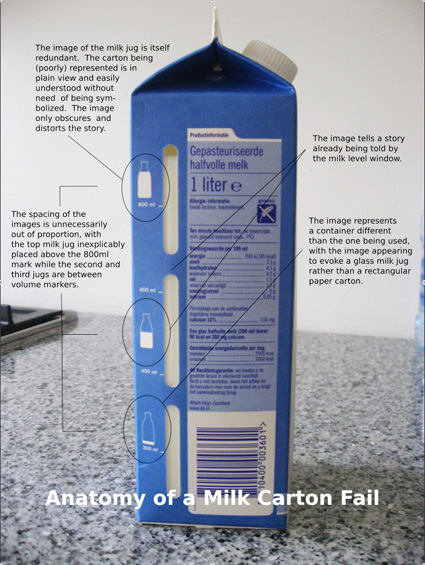
Came across this interesting design commentary by Joseph Logan, describing how a transparent window in the milk carton (ostensibly a good idea to have a quick, real time, reliable way to tell how much milk is left) degenerated into something that is a whole lot less elegant, simply by adding more and more visual elements (inappropriately too):
A designer suggested adding a little window on the carton to provide something easier for making a shopping list than a rough weight estimate. The first round of design review probably added the volume markers, which are innocuous enough but unnecessary for the majority of milk drinkers. Subsequent rounds probably added the wholly useless picture of the milk jugs and the placement of all this visually distracting detritus.
Is there anything beyond the little windows that substantially improves your ability to make decisions about the volume of milk? Of course not.
What is actually happening here is that a potentially useful addition to the good old milk carton becomes something cluttered and misleading, and it smacks of committee work. Will any harm come of it? Probably not. At most, it might be a little more confusing than necessary to anyone who bothers to look at it, which probably won’t be too many of us. Imagine safety diagrams on an airplane or in a chemical plant, though; how much distraction or confusion would be necessary to cause an accident?
Hear hear~ that is also something that I come across once in a while in my day-to-day job. It’s quite easy to slip into the chasm of “isn’t more of something good better?”, and forget the delightful balance and restraint that must sometimes take priority instead. Or to push design concepts all the way to the extreme ends of a cross-matrix – where subtlety is erased and diminished.
Problematically, these are also typically calls that you can’t rationally make a rule of. How do you know when ‘too much’ is, in fact, too much? In these times, it simply boils down to good judgment, clarity of intent and experience.

